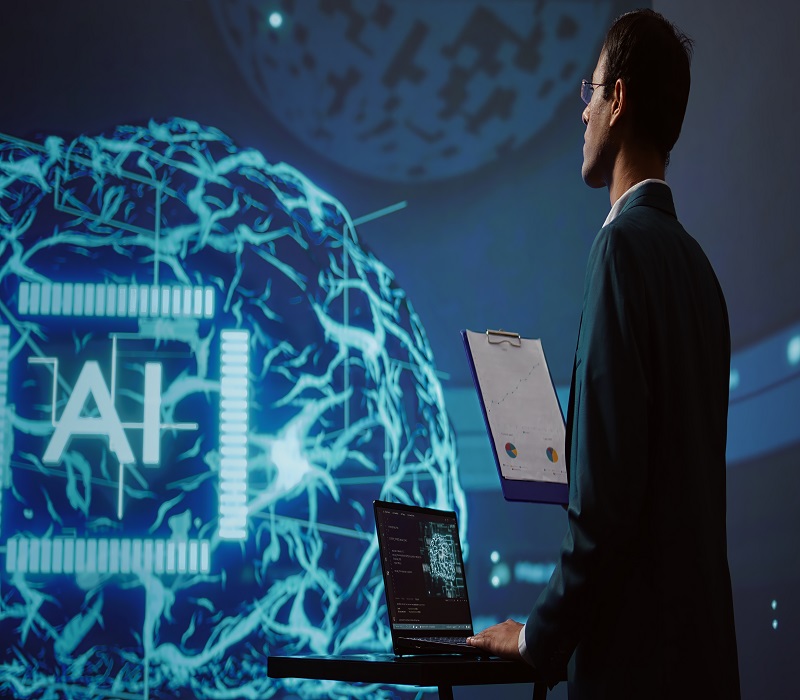From the personalized recommendations on your streaming service to the voice assistant in your smartphone, Artificial Intelligence (AI) has seamlessly integrated into the fabric of our daily lives. Once a concept confined to science fiction, AI is now a powerful, driving force in the global technological landscape. But what exactly is it, how does it work, and what does its future hold?
What is Artificial Intelligence?
At its core, Artificial Intelligence is a broad field of computer science dedicated to creating systems capable of performing tasks that typically require human intelligence. These tasks include learning, reasoning, problem-solving, perception, and understanding language.
The overarching goal of AI is not to replicate the human brain in its entirety but to develop tools that can augment human capabilities and automate complex processes efficiently and accurately.
The Different Types of AI
AI is not a monolith; it exists on a spectrum, often categorized into three types:
- Artificial Narrow Intelligence (ANI): This is the only form of AI that exists today. ANI is designed and trained to complete a specific, narrow task. While it may outperform humans in its designated function (like playing chess, identifying images, or filtering spam), it operates under a limited set of constraints. Examples include Google Search, Siri, and autonomous vehicles.
- Artificial General Intelligence (AGI): This is the concept of a machine with the ability to understand, learn, and apply its intelligence to solve any problem, much like a human being. AGI would possess self-awareness and consciousness. This remains a theoretical concept and an active area of research.
- Artificial Superintelligence (ASI): This hypothetical AI would surpass human intelligence and cognitive ability in every conceivable way, including creativity, general wisdom, and problem-solving. ASI is a topic of significant philosophical and ethical debate.
How Does AI Work? The Role of Machine Learning and Deep Learning
Modern AI is largely powered by two interconnected subfields:
- Machine Learning (ML): ML is the primary method for achieving AI. Instead of being explicitly programmed for every task, ML algorithms are trained on large amounts of data to identify patterns and make decisions or predictions. They learn and improve their performance over time with exposure to more data.
- Deep Learning (DL): A more advanced subset of ML, Deep Learning uses artificial neural networks—complex structures inspired by the human brain—with many layers (“deep” networks). These networks can process enormous datasets and learn incredibly intricate patterns, enabling breakthroughs in fields like computer vision (e.g., facial recognition) and natural language processing (e.g., chatbots like ChatGPT).
Real-World Applications of AI
AI’s applications are vast and transformative across industries:
- Healthcare: AI algorithms analyze medical images (X-rays, MRIs) to detect diseases like cancer earlier and with high accuracy. They also assist in drug discovery and personalized medicine.
- Transportation: Self-driving cars use AI to perceive their environment, navigate obstacles, and make split-second decisions.
- Finance: Banks use AI for fraud detection by spotting anomalous transactions, for algorithmic trading, and for managing risk.
- Retail & E-commerce: Recommendation engines (like those on Amazon and Netflix) use AI to analyze your behavior and suggest products or content you might like.
- Manufacturing: AI-powered robots perform complex assembly tasks, while predictive maintenance systems forecast when industrial machines will need servicing.
The Ethical Considerations and Future Outlook
The rapid ascent of AI brings crucial challenges that society must address:
- Bias and Fairness: AI systems can inherit and amplify biases present in their training data, leading to discriminatory outcomes.
- Privacy: The vast data collection required to fuel AI raises significant concerns about surveillance and personal privacy.
- Job Displacement: Automation through AI could render certain jobs obsolete, necessitating a shift in the workforce and new skills training.
- Accountability: Determining who is responsible when an AI system makes a harmful decision—the developer, the user, or the algorithm itself—remains a complex legal and ethical question.
Disclaimer
The information provided in this article is for general informational and educational purposes only. The author and publisher make no representations or warranties of any kind, express or implied, about the completeness, accuracy, reliability, suitability, or availability of the content herein.
The field of Artificial Intelligence is rapidly evolving. The technologies, applications, and ethical considerations discussed may change or be updated after the publication of this article. The views expressed are those of the author based on current understanding and do not constitute professional advice.
Readers are encouraged to conduct their own research and consult with qualified professionals for specific advice tailored to their situation. The author and publisher will not be liable for any errors or omissions in this information nor for any losses, injuries, or damages arising from its display or use. All information is provided on an “as-is” basis.




I love how the article touches on the different types of AI. The fact that ANI is already so good at specific tasks like chess or image recognition makes me wonder how AI will continue to evolve and impact fields like healthcare and education in the coming years.
I like how you emphasizedBlog comment creation that most AI today falls under Narrow AI—it’s a useful reminder that while AI feels advanced, it’s still limited to very specific tasks. It makes me wonder how the transition to more general AI will reshape the ethical considerations you mentioned, especially around decision-making and accountability. Do you think society is moving fast enough in creating guidelines to keep up with these changes?
I like how youAI blog comment creation broke down the spectrum of AI, especially highlighting that what we have today is still just Narrow AI. It’s interesting to think about how quickly everyday tools—like recommendations and voice assistants—have normalized AI without most people realizing they’re interacting with it. I wonder how public perception will shift once we start seeing broader forms of AI enter practical use cases beyond single-task systems.
AI’s ability to enhance specific tasks is fascinating, but it’s clear that the future holds even more potential. As we develop more advanced systems, balancing automation with ethical considerations—like job displacement and privacy—will be crucial.
IBlog comment creation like how you highlighted the distinction between narrow AI and the broader vision of intelligence. It’s interesting that, while ANI powers so many of our daily tools, most people assume we’re closer to general AI than we actually are. I think it raises an important question—how do we bridge public perception with the real state of AI development?
Blog comment creationI like how you broke down the distinction between Artificial Narrow Intelligence and broader forms of AI—it’s easy to forget that what we interact with daily is still limited in scope. One angle I think is worth exploring further is how ANI systems, even though narrow, can be combined to create more complex behaviors that feel closer to general intelligence. That transition point could raise some interesting ethical and practical challenges for the future of AI development.